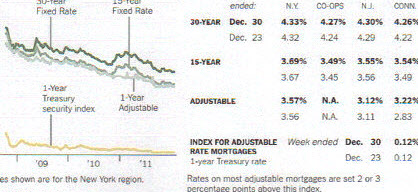For information about coastal Los Angeles real estate and Orange County CA homes, call Bob Cumming of Keystone Group Properties at 310-496-8122. Keystone Group Properties services buyers and sellers of Southern California coastal luxury homes.
What Went Wrong With Foreclosure Aid Programs
At the time, they thought they were being reviewed for a loan modification through the U.S. government’s foreclosure-prevention program.A Realtor knocking on their door to tell them to vacate told them otherwise.
“I’m bitter,” says Harry Johnson. “We did everything they told us to do.”
The Johnson’s are angry not only at their mortgage company, but also at the government, and they’re two voices among a discontented chorus.
The Obama administration’s initial foreclosure-prevention programs, launched in early 2009, were intended to help 7 million to 9 million people. So far, they’ve aided about 2 million, and not all of those are out of foreclosure danger.
Programs begun later have also faltered. One intended to help at least 500,000 has helped just a few hundred a year after its launch. Another initiative to extend $1 billion to help the jobless or underemployed avoid foreclosure ended in September, obligating less than half of its funds. The unused money went back to the U.S. Treasury.
As of Nov. 30, the government had spent just $2.8 billion of the $46 billion war chest it had in 2009 to devote to the housing crisis, the Treasury Department says. More has been committed, but only $13 billion will ultimately be spent, the non-partisan Congressional Budget Office estimated in March.
Meanwhile, 2.5 million homes have been lost to foreclosure since 2009, an additional 4 million are in the foreclosure process or seriously delinquent, and home prices are still falling in much of the U.S., shrinking household wealth for millions of Americans.
“Every program has fallen far short of goals. I can’t think of one that’s been largely successful,” says the director of an Unemployment Project, a non-profit that’s been involved in foreclosure prevention for decades.
The administration’s programs were hampered by design flaws, their reliance on a mortgage industry overwhelmed by the fallout from a historic collapse in home prices, and a brutal extended housing downturn. Nor could they always overcome the conflicting interests of borrowers with too much debt, mortgage investors unwilling to surrender profits and mortgage servicers with sometimes greater financial incentives to foreclose on loans than to permanently modify them, say housing and government policy analysts, consumer advocates and former administration officials.
Critics also say the administration failed to entice banks and mortgage-finance giants Freddie Mac and Fannie Mae to take bolder steps to address the crisis even though the institutions received billions in government bailout funds.
“There was nowhere near the effort to help Main Street as there was to help the banks,” says former senator Ted Kaufman, D-Del., who chaired a congressional oversight panel that oversaw $475 billion in Troubled Asset Relief Program (TARP) funds. Most of that went to banks and the auto industry, but $46 billion in TARP money also funded foreclosure-prevention efforts.
Administration officials defend their response. They say the scope of the problem was unprecedented — and so were their actions. Federal programs prevented many foreclosures even if they didn’t help as many people as expected, officials say. They say the administration’s efforts will save homeowners billions in mortgage costs.
They also say the initiatives helped millions of other homeowners by driving service improvements in the mortgage industry and preventing an even worse collapse in home prices. Since the peak of the housing market in 2006, $3 trillion in home equity has been lost, researcher LPS Applied Analytics estimates.
“It’s too easy to underestimate the scale and complexity of these issues,” Shaun Donovan, secretary of Housing and Urban Development, said in a recent interview, while acknowledging that some administration programs “haven’t reached as many people as we originally targeted.”
Those shortfalls are most evident in the:
•Home Affordable Modification Program (HAMP). Through October, the biggest foreclosure-prevention effort has resulted in 883,076 homeowners getting permanent loan modifications that made their loans more affordable and improved their ability to avoid foreclosure.
But HAMP was targeted to help 3 million to 4 million homeowners,President Obama said when he announced it in 2009. When it expires next December, it will have prevented fewer than 800,000 foreclosures, Kaufman’s congressional oversight panel estimated in December 2010.
HAMP “has been a failure,” Neil Barofsky, the former special inspector general for TARP, told a congressional committee in October.
•Home Affordable Refinance Program (HARP). Through September, it’s helped 928,570 homeowners get lower-interest loans even though they lacked the amount of equity usually needed for a new loan.
HARP was intended to help 4 million to 5 million homeowners. While it was recently overhauled to encourage more refinancing, federal officials now say it will help fewer than 2 million borrowers by the end of 2013, when it expires.
So far, those getting HARP refis also tend to be people who aren’t deeply underwater — those who owe more on their homes than they’re worth. HARP refis have gone largely to homeowners with some equity or who were only slightly underwater, government data show. It’s unclear whether the recent revamping will significantly change that, says Alan White, law professor and mortgage lending expert at the Valparaiso University School of Law.
More than 11 million homeowners — more than a fifth of homeowners with mortgages — are underwater, says market researcher CoreLogic. Many are unable to take advantage of today’s historically low interest rates and wring some relief from the ravages of the recession and weak economic recovery.
Rep. Dennis Cardoza, D-Calif., whose district encompasses Stockton, one of the nation’s worst foreclosure hot spots, says more needs to be done and that the changes to HARP are “too little, too late.”
•Federal Housing Administration Short Refinance program. Intended to help 500,000 to 1.5 million homeowners refinance into loans with a lower interest rate, the FHA program did fewer than 400 deals through September, a year after the effort’s launch, government data show.
The program requires mortgage owners to forgive at least 10% of a borrower’s unpaid principal before that loan can be refinanced into an FHA loan at a lower interest rate.
But mortgage owners have been reluctant to forgive principal, fearing that doing so for some would create a “moral hazard,” leading other borrowers to default to get help, says James Parrott, a senior adviser to the White House’s National Economic Council.
“The moral hazard concern was stronger than we realized,” Parrott says.
One big bank says it warned of the program’s limitations.
Bank of America, which services 12 million mortgages, gave federal officials data showing the program would benefit only 10,000 to 15,000 customers because of its design and the degree of support from investors who owned loans, says spokesman Dan Frahm.
Almost 1 million modifications
Administration officials say the programs’ statistics alone don’t fully reflect what’s been accomplished. “You have to look at the ripple effect,” Donovan says.
HAMP, which most often lowers mortgage payments through interest rate reductions, is approaching 1 million permanent loan modifications.That is “not a negligible sum,” Parrott says.
HAMP also “significantly changed the market,” says Michael Barr, former assistant secretary at Treasury who worked on mortgage issues while in the Obama administration.
Before HAMP, mortgage servicers had no standard approach to modify loans. HAMP created one and streamlined the process, says Barr, who now teaches at the University of Michigan Law School.
Since HAMP’s launch, lenders have independently offered more than 2.5 million loan modifications outside of HAMP, staving off foreclosures for many.
“The overall impact of the (HAMP) program has gone unnoticed,” says Teri Schrettenbrunner, senior vice president of communications for Wells Fargo Home Mortgage.
HAMP was announced just weeks after Obama took office and at a time when home prices had fallen for 30 months in a row.
Given the short time the administration took to launch HAMP and HARP, “We knew they wouldn’t be perfect. We knew they’d be as good as they could be given the time we had,” Barr says.
He says a prime reason that government programs haven’t reached more people is that mortgage servicers “were really bad at doing their jobs.”
Servicers collect home loan payments for investor-owners. Big banks, such as Bank of America, Wells Fargo and JPMorgan Chase, are among the largest ones.
The servicers lacked adequate processes and enough employees to meet the crush of distressed borrowers, Barr says. They took too long to beef up staff. They couldn’t do “basic blocking and tackling” in communicating with borrowers, he says.
The Government Accountability Office documented problems when it surveyed housing counselors who work with borrowers seeking HAMP modifications. Almost 60% complained that servicers lost documents, 54% said trial modifications took too long, and 42% said borrowers felt that they were wrongly denied modifications, according to the GAO’s report in March.
The Johnson’s weren’t the only ones who lost a house to foreclosure while thinking help was on the way. Others did, too, said Treasury official Darius Kingsley in congressional testimony in October. He called such situations egregious.
The administration casts much of the blame on the industry, but others blame the government.
Barofsky says Treasury had to have known that servicers were “totally unequipped” to handle HAMP when it launched. Still, it rushed out a “poorly designed program,” he says.
Servicers say changing program guidelines made it tough to implement the government programs.In a three-month period, Treasury made 100 changes to HAMP, making it “physically impossible” for servicers to keep up, said Barbara Desoer, president of Bank of America Home Loans, in a recent speech to community leaders in San Francisco.
HAMP provides financial incentives — generally about $4,000 a loan — to servicers to modify loans.The goal is to make it more economical for servicers to modify a loan than to foreclose.But the incentives weren’t big enough to draw broader servicer participation, says Jared Bernstein, former economic policy adviser to Vice President Biden.What’s more, the government made HAMP a voluntary program for servicers, then failed to make sure that participating servicers followed HAMP’s rules, consumer advocates say.
HAMP ran for two years before financial incentives were withheld from any uncompliant servicer, even though abuses were “widespread,” Barofsky says.
“There’s been no enforcement or accountability,” says Diane Thompson of the National Consumer Law Center.
The $1 billion Emergency Homeowner Loan Program was open to homeowners in 32 states who were ineligible for aid from a $7.6 billion fund for homeowners in 18 states hardest hit by the recession and falling home prices.
HUD took too long to launch the program, which didn’t leave enough time to get applicants through an onerous application process, consumer advocates say.
Instead of helping 30,000 homeowners as first intended, the program is on track to help fewer than 12,000, HUD’s preliminary data show.That “is an absolute disgrace,” says Ira Rheingold, executive director of the National Association of Consumer Advocates.HUD officials say it took time to identify contractors to run the program, set up fiscal controls and ensure the program was run fairly.”We, too, are disappointed,” Carol Galante, a senior HUD housing official, testified at a congressional hearing in October.
More but smaller plans to come
New efforts are underway, but none appear to have the scope of previous plans.
State attorneys general and federal officials are negotiating a multibillion-dollar settlement with major mortgage servicers to help more homeowners.
If a deal is struck, it will include principal forgiveness on more home loans, Donovan says. That may show loan owners that forgiving principal really does lead to fewer defaults, Rheingold says, and encourage more of it.
Most of the $7.6 billion in Hardest Hit Funds, too, have yet to reach the market. States have through 2017 to use those funds.The Treasury Department also says there are still 1 million homeowners who could be eligible for HAMP.”We’re going to keep fighting to fix this housing market,” Donovan says



